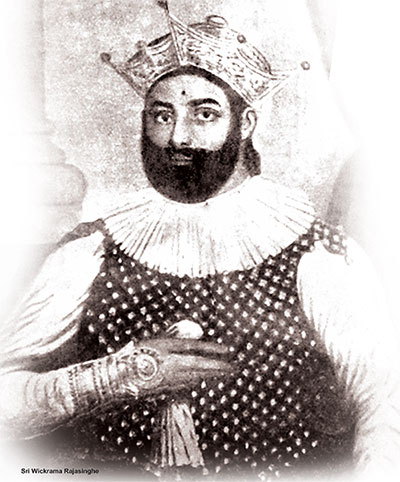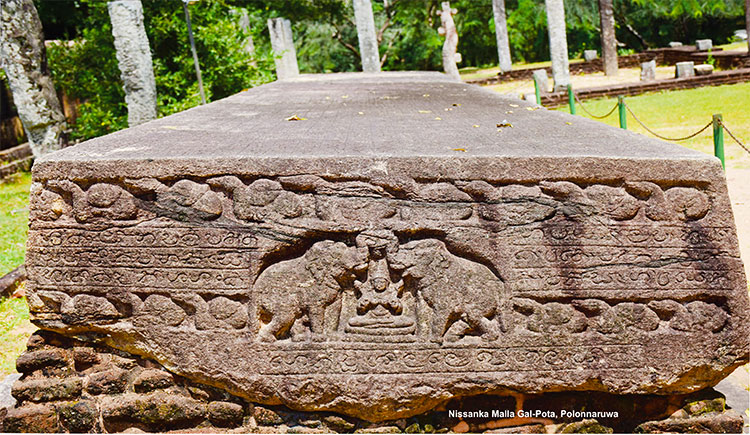Rescuing Sri Lankan history: Reflections on the past
By Uditha Devapriya
2021/10/30

In his influential essay “The People of the Lion”, R. A. L. H. Gunawardana argues for a national historiography, devoid of Western ideology. He does not refute or call for the doing away of such ideology altogether, but suggests rather that it has intruded on studies of group identities to such an extent that the history we think we unearth is very different to the history that may actually have prevailed.
Thus, by imputing terms like “race” (a term originating in 16th century Europe) and “Aryan” (which gained prominence with attempts by Orientalist scholars to draw parallels between Indo-Lankan and European languages), we are, as he points out, “presenting a view of the past moulded by contemporary ideology.” If this is the case, which I personally think it must be, then what is the history we have and the history we must talk of?
What we know, from the inscriptions, the chronicles, and the reconstructed narratives, is that Sri Lankan society was never really rooted in the concept of race as it is today. Group ideology was determined by tribes that migrated from other societies. The first hunter-gatherers lacked iron implements, which is how they came to be assimilated by Indo-Aryan Iron Age settlers. While these hunter-gatherers are said to have approximated to Veddhas, the later Iron Age settlers are said to have approximated to Sinhala people.
The question of whether hunter-gatherers formed an agricultural group is debated: the Valahassa Jatakaya, for instance, tells us of she-yakkas devouring food from wrecked ships and enslaving, if not tormenting, the sailors aboard them, while the Mahavamsa relates an episode of Vijaya coming across these ships after his encounter with Kuveni. Fa-Hsien was, as K. M. de Silva observes, not being very helpful in these matters when he wrote that the country had been originally inhabited by yaksas and nagas who traded with merchants, simply because human settlements predated both those clans.
Such narratives divided not just scholars, but also littérateurs: Martin Wickramasinghe in Sinhala Sahithyaye Nageema argued that the existence of such ships showed the absence of an advanced pre-Vijayan agricultural society, while the pioneers of the Hela Havula stated that Kuveni having engaged herself with a spinning wheel at the time of Vijaya’s entrance showed that society had been advanced prior to Indo-Aryan colonisation.
The issue is that these texts were occupied more with idealising a religious or dynastic sect than with presenting a view of life as it was lived. If they presented such a view, which they occasionally did, they did so in a hazy, amorphous way. This requires us to turn to hard evidence, etched in stone and recorded for posterity.
The Brahmi inscriptions form arguably the most concrete evidence we have for the civilisation which developed, grew, and flourished after the Indo-Aryan migration. These inscriptions come to us from very early on, and they were made by the upper classes of their time. We have Yaksha, Naga, Vedic, and Puranic inscriptions, and they allude to the status of their authors, their families, and their occupations.
The Puranic inscriptions tell us of pre-Buddhist religious cults which revolved around the Mother Goddess, Vishnu, and Siva, a point that lends credence to G. P. Malalasekara’s view that Vijaya was tolerant of all faiths. Evidence from the inscriptions of Jain and Tamil settlements, as well as settlements by, inter alia, Kabojas (Kashmiris), Moriyas (Mauryas), and Baratas (merchants, or nobles according to Paranavitana) tells us that we were a multiracial country, at least in terms of “contemporary ideology.”
But these clans were so disparate that they found it hard to develop a cohesive identity. They identified themselves by a totem: Moriyas with the peacock, Lambakannas the hare, Kulingas the shrike, and Tarachchas the hyena. This continued into the evolution of group identities later, as evidenced by the use of the lion and the tiger: the former became the standard of the “Sinhala” people, whereas the latter was adopted by the Nayakkar kings of Kandy who ruled over those same “Sinhala” people.
Not surprisingly, in medieval Sri Lankan society the ideology of the ruling class became the identity of the State. What this meant was that there was no overriding racial consciousness of the sort we discern today, so much so that, for instance, when Dutugemunu went to war we had, not Sinhalas fighting Tamils, but one dynasty battling another.
“Sinhala Buddhism”

was probably not rooted in society the way it is now, and if it was, the needs of the sasana would have been considered more important than ethno-nationalist considerations: the author of the Mahavamsa, after all, has Dutugemunu say he’s fighting “not for the joy of sovereignty”, but for the preservation of the Order.
The vague position Buddhism occupied at this juncture can be gleaned from the fact that it was accorded a foremost status even by invading forces, at least in the case of Elara; the Mahavamsa valorises him as a just ruler, tainted only by his “false beliefs.” In contrast, after the 10th century we see a heightening of anti-Buddhist and anti-Jain sentiment among South Indian invaders, which in turn produces a backlash on Sri Lankan soil.
In an otherwise eloquent essay on the subject (“Buddhism, Identity, and Conflict”), H. L. Seneviratne contends that Sri Lankan society was never the ekeeya rajya it is touted as by ultra-nationalists. He is theoretically correct, yet there is an important caveat that must be inserted: that the Westphalian notion of sovereignty was alien to the rulers of the land and thus not totally applicable, at least not to the extent it is today.
To be sure, “particularism” persisted in Anuradhapura, and the absence of a proper central administration in Polonnaruwa contributed to the disintegration of the rajya, denuding it of any ekeeya pretensions. Yet, at the same time, group consciousness permeated society even at the level of a divided State. That is why regional polities tended to band together in the face of military incursions from India, and why the absorption of those polities into a central State in Polonnaruwa under Parakramabahu I deprived the Sinhala kingdom of a viable base from which it could strategise counter-campaigns against such incursions.
In the aftermath of Kalinga Magha’s military campaigns during the Polonnaruwa era, we see a strengthening of a local Buddhist identity in response to the threat of fragmentation of the State, ekeeya or otherwise. It was a classic case of hostility by an invading force giving rise to a group identity on the invaded terrain. Nissanka Malla’s decree that only a Buddhist could rule the land hence must be seen in the light of Magha’s later campaigns of destruction. The fact that this “Buddhist king” himself is said to have originated from the Kalinga line speaks volumes about the amorphous nature of group identity formation.
To be sure, there was opposition to an ethnic Other occupying the throne, but we must understand that it was never the kind of opposition ultra-nationalists project towards the prospect of an ethnic Other presiding over Sri Lanka today.
When Bhuvanekabahu VI faced an uprising in the south, for instance, it was later painted as an uprising against a ruler of Malayali blood; this did not stop chroniclers from celebrating him for his conquest of Jaffna. The case of Waththimi Kumaraya is also significant: while the records are unclear, what we have is an account of a Muslim pretender being killed by a group of nobles, only to be venerated later by Muslims and Buddhists – the latter of whom worship him as Gale Bandara Deviyo. The level of ignorance displayed by ultra-nationalists to such subtle nuances of history surfaced years ago when, after I noted that Gale Bandara Deviyo may have had Muslim origins, a young lad of 19 protested his origins and suggested to me that, because he was non-Buddhist, he should not be venerated!
We see such ambiguities in the Kandyan era as well. However, despite Gunawardana’s assertion that uprisings by the aristocracy against rulers were a common occurrence even prior to the advent of Nayakkar rule, we must admit that such uprisings became more and more common after the installation of the Nayakkar line on the throne.
The contrast between the Ingirisihatana and the Vadigahatana must be considered in this light: the former celebrated Sri Wickrama Rajasinghe for his victory over the British in 1803, while the latter was written by Kavisundara Mudali, a confidante of Eheliyapola Adikaram who was antagonistic towards the king, following the annexation of 1815.
If that sounds strange, consider that the writers of historical chronicles have always, since the time of the Dipavamsa and the Mahavamsa, tilted in favour of one group over another. That is why we see a great deal of Dutugemunu, and so little of Mahasen, who Mahanama Thera seems to have mentioned, if at all, for his efforts at developing the irrigation system of the land. Curious as such paradoxes may be, they survived well into the British era, when the continuation of the Mahavamsa depicted the British as heroic, even though the author, Yagirala Pannananda, received no proper backing from the State.
In any case, it’s one of the biggest ironies of history that the Vadigahatana and the Kirala Sandeshaya called out on the wickedness of Sri Wickrama Rajasinghe by identifying himself with an ethnic Other, when the Nayakkar line had been chosen after the death of Vira Parakrama Narendrasinghe to head the country because there had been no Sinhalese of kshatriya blood (a sine qua non of kinship in the post-Nissanka Malla era) available; certain nobles had wanted Unamboowe, but he was not “pure”.
It is also ironic that each and every anti-British uprising after 1815 required a Nayakkar pretender; the exception, after which no Nayakkars reclaimed the fight, was 1848. Such facets have long been forgotten by those who insert contemporary ideology into the past: perhaps the most grievous error we can commit, not just to history, but to our history. To rescue that history thus requires a radical re-evaluation of our past.

The writer can be reached at udakdev1@gmail.com

Leave a Reply
You must be logged in to post a comment.